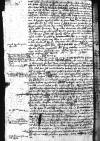Letter #3299
[Ioannes DANTISCUS] & [part of the Royal Prussia' Council] to Sigismund I Jagiellon[Heilsberg (Lidzbark Warmiński)?], 1547-12-21
Manuscript sources:
Auxiliary sources:
| ||||||||
Text & apparatus & commentary Plain text Text & commentary Text & apparatus
{Serenissime etc.} Serenissime Princeps, Potentissime Rex et Domine, domine clementissime.
Humillimam fidelissimorum servitiorum nostrorum in gratiam Serenissimae Maiestatis Vestrae commendationem.
Cum non parum nos,
Consultum itaque visum est quibusdam ex dominis
Hoc cum pio debito et officio nostro Serenissimae Maiestati Vestrae ex aliorum quibusdam dominorum
Cui nos humillime commendamus eidem prosperrimam et longissimam valetudinem cum omnium rerum felicissimo accessu ex animo precantes.
Datae ex aedibus nostris sub unius nostrum sigillo, XXI Decembris MDXLVII.
